Work-Energy Fundamentals - Complete Toolkit
Objectives
- To describe the conditions under which positive and negative work are done and to use the work equation to calculate the amount of work done.
- To define potential energy, to identify the two forms and the variables that affect the amount of each form, and to calculate the potential energy possessed by an object.
- To define kinetic energy, to identify the variables that affect the amount, and to calculate the kinetic energy possessed by an object.
- To identify the two forms of mechanical energy, to distinguish between mechanical and non-mechanical energy, to describe the relationship between mechanical energy and work, and to relate the total mechanical energy (TME) to the amounts of kinetic energy (KE) and potential energy (PE).
- To distinguish between power and work and to use two power equations to calculate the power.
Readings from The Physics Classroom Tutorial
Interactive Simulations
- PhET: Masses & Springs Interactive
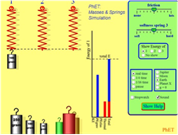 This realistic mass-and-spring sim is a great way to visualize changing kinetic and potential energy in a spring system. You can change the weight of the hanging mass, spring stiffness, damping, and the initial applied force. Real-time bar graphs are displayed of KE, Gravitational PE, Elastic PE, and Thermal energy. Jump to the moon or Jupiter to see how this affects the energy ratios (and expect a few surprising results)!
This realistic mass-and-spring sim is a great way to visualize changing kinetic and potential energy in a spring system. You can change the weight of the hanging mass, spring stiffness, damping, and the initial applied force. Real-time bar graphs are displayed of KE, Gravitational PE, Elastic PE, and Thermal energy. Jump to the moon or Jupiter to see how this affects the energy ratios (and expect a few surprising results)!
Bonus: A turn-key 90-minute lesson on Hooke’s Law – students use the sim to explore how displacement of a spring is mathematically related to the load applied to it. Includes Student Guides w/answer key.
Companion Lesson: Hooke's Law
 Clicker Questions for Masses & Springs
Clicker Questions for Masses & Springs
Masses & Springs: Clicker Questions
This set of 9 warm-up questions is available in pdf or Power Point format. Choose the PPT for access to answer key. The author, Trish Loeblein, is a PhET Gold Star winning teacher-contributor. This presentation was developed specifically to accompany the PhET simulation “Masses & Springs”.
- It's All Uphill
 The It's All Uphill Interactive provides a tool to investigate the effect of an incline angle upon the amount of work (and amount of force) required to pull a cart up the incline at constant speed. The cart is elevated to the same height on each trial. The force applied to the cart is displayed on the screen and the displacement of the cart can be measured. This HTML5 Interactive works well on tablets such as the iPad, Chromebooks, and traditional desktop and laptop devices. The Interactive is accompanied by a lab sheet for use in the classroom.
The It's All Uphill Interactive provides a tool to investigate the effect of an incline angle upon the amount of work (and amount of force) required to pull a cart up the incline at constant speed. The cart is elevated to the same height on each trial. The force applied to the cart is displayed on the screen and the displacement of the cart can be measured. This HTML5 Interactive works well on tablets such as the iPad, Chromebooks, and traditional desktop and laptop devices. The Interactive is accompanied by a lab sheet for use in the classroom.
- PhET Simulation: The Ramp
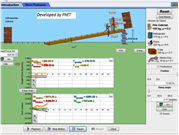 In this simulation, students push common objects of various masses up an incline to explore the relationship of applied force, work, and energy. They can control the angle of the ramp, friction, and amount of applied force. Detailed graphs of work and energy are simultaneously displayed.
In this simulation, students push common objects of various masses up an incline to explore the relationship of applied force, work, and energy. They can control the angle of the ramp, friction, and amount of applied force. Detailed graphs of work and energy are simultaneously displayed.
Accompanying Lesson Plan:
Companion Teacher Lesson: "The Ramp"
This is a fully turn-key 50-minute activity, authored by a high school teacher, to accompany PhET’s simulation “The Ramp”. The lesson objective is focused (thus appropriate for a flipped lesson): How is the angle of inclination of a ramp related to forces acting on the object moving on the ramp?
- Energizer Model
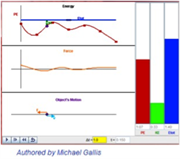 This interactive model explores the relationship between kinetic, potential, and total energy. Students drag markers to create a 1-D curved track, then drag the motion marker to set an initial position. The “hills” can be large or small in height. Click Play and watch the object travel along the user-created curve. Bar graphs of KE, PE, and total energy are displayed in real time alongside the curve.
This interactive model explores the relationship between kinetic, potential, and total energy. Students drag markers to create a 1-D curved track, then drag the motion marker to set an initial position. The “hills” can be large or small in height. Click Play and watch the object travel along the user-created curve. Bar graphs of KE, PE, and total energy are displayed in real time alongside the curve.
- Virtual Trebuchet
 We like this free simulator because it's simple to use, yet introduces a plethora of conditions. You can set the length of the short arm and long arm, length of the weight, height of the pivot, mass and inertia of the arm, mass of the projectile, ratio of the pivot/arm's center of gravity, mass of the counterweight, wind speed, and release angle. It includes a short tutorial section and links to user-contributed projects.
We like this free simulator because it's simple to use, yet introduces a plethora of conditions. You can set the length of the short arm and long arm, length of the weight, height of the pivot, mass and inertia of the arm, mass of the projectile, ratio of the pivot/arm's center of gravity, mass of the counterweight, wind speed, and release angle. It includes a short tutorial section and links to user-contributed projects.
Video and Animations
- PBS Learning Media: Energy Transfer in a Trebuchet
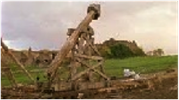 This entertaining short video features a team of engineers who recreate a medieval trebuchet using only technologies available in the Middle Ages. The design team started with small physical models, ending with a massive device that hurls a piano. It promotes understanding of the mechanical advantage of levers and the importance of modeling a process before implementing a design (the first model was wobbly and dangerous). It also does a good job of exploring the advantage of the off-center pivot point of the lever and the purpose of the heavy counterweight (which revolutionized catapult-type projectile warfare).
This entertaining short video features a team of engineers who recreate a medieval trebuchet using only technologies available in the Middle Ages. The design team started with small physical models, ending with a massive device that hurls a piano. It promotes understanding of the mechanical advantage of levers and the importance of modeling a process before implementing a design (the first model was wobbly and dangerous). It also does a good job of exploring the advantage of the off-center pivot point of the lever and the purpose of the heavy counterweight (which revolutionized catapult-type projectile warfare).
- Trebuchet Physics: Make Your Trebuchet Throw Farther
 We figured you already have your favorite videos of punkin’ chunkin’ or projectile launching competitions. But you probably haven't seen anything quite like this 6-minute video that explores useful tricks to make a more successful trebuchet design. It introduces diagrams showing the medieval trebuchet design vs. the modern floating arm trebuchet, and brings in the relevant math as well.
We figured you already have your favorite videos of punkin’ chunkin’ or projectile launching competitions. But you probably haven't seen anything quite like this 6-minute video that explores useful tricks to make a more successful trebuchet design. It introduces diagrams showing the medieval trebuchet design vs. the modern floating arm trebuchet, and brings in the relevant math as well.
- Smarter Every Day: The Physics of Slingshots
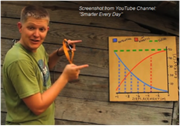 Mechanical Engineer Destin Sandlin works with a high-speed Phantom camera to bring you great slow-motion views of slingshots in action. The photography is fantastic, but the physics explanation is where the rubber meets the road in this video. Destin uses a graph of Potential and Kinetic Energy vs. Displacement to illustrate the total energy of the slingshot system. Next, he conducts a trial to see which design gives the best performance: a straight band or a tapered band with less material. The Phantom Cam lets you do video analysis to see the results. Excellent resource for blending engineering and physics.
Mechanical Engineer Destin Sandlin works with a high-speed Phantom camera to bring you great slow-motion views of slingshots in action. The photography is fantastic, but the physics explanation is where the rubber meets the road in this video. Destin uses a graph of Potential and Kinetic Energy vs. Displacement to illustrate the total energy of the slingshot system. Next, he conducts a trial to see which design gives the best performance: a straight band or a tapered band with less material. The Phantom Cam lets you do video analysis to see the results. Excellent resource for blending engineering and physics.
Related Physics Education Research (Free Download)
Energy as a Substancelike Quantity that flows: Theoretical Considerations and Pedagogical Consequences, by Eric Brewe, Phys. Rev. ST Phys. Educ. Res. 7 (2), 021006 (2001)
http://www.compadre.org/PER/document/ServeFile.cfm?ID=11936&DocID=2847
Did you know that some prominent people in physics education are suggesting a complete reorganization in how we teach energy? Physics educator Eric Brewe discusses the approach, in which "energy-as-a-substance" is the central feature of the course. This framework includes early incorporation of energy into the curriculum to emphasize energy's role in modeling physical systems and as the schema for analysis of systems. This energy-centric approach has received recent attention as a more cohesive way for students to understand the relationship between force and energy.
Project-Based Learning Module
- GreenLearning-Canada: Build A Wind Turbine Lesson Module
 This web page provides step-by-step instructions for building a vertical axis wind turbine in secondary classrooms. The 17-page construction plans may be freely downloaded and are organized for first-time builders. All of the materials are readily available in hardware or grocery stores. Note: Wind turbines work by using an internal generator to convert the mechanical energy of the spinning turbine shaft into electricity. This particular project is modeled after the Savonius rotor system, which uses drag -- not lift -- to capture energy for making electricity. Although it isn't as efficient as a conventional horizontal axis turbine, it is much easier to build.
This web page provides step-by-step instructions for building a vertical axis wind turbine in secondary classrooms. The 17-page construction plans may be freely downloaded and are organized for first-time builders. All of the materials are readily available in hardware or grocery stores. Note: Wind turbines work by using an internal generator to convert the mechanical energy of the spinning turbine shaft into electricity. This particular project is modeled after the Savonius rotor system, which uses drag -- not lift -- to capture energy for making electricity. Although it isn't as efficient as a conventional horizontal axis turbine, it is much easier to build.
Companion Animated Video shows how a modern wind turbine converts kinetic energy from wind into mechanical energy that drives a mater shaft in powering a generator. Inside the generator, an electromagnet converts the mechanical energy to electrical energy. http://fwee.org/nw-hydro-tours/how-wind-turbines-generate-electricity/
Extra Support: Below is a web page that provides a mathematical formula for the power delivered by a wind generator. It explains how the formula is related to transformation of energy among the system’s components: Calculating Power Delivered by a Wind Generator

Physlet Physics: Animation-Based Illustrations and Explorations
- Physlet Physics: Constant Forces
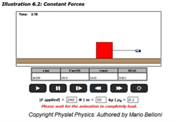 Kinetic friction will always oppose motion, so it will always reduce kinetic energy. This animation lets students explore change in kinetic energy as a moving mass experiences frictional force. The mass can be changed from 50-500 km, the applied force can be changed from 0-1000 N, and the coefficient of friction can be set between 01.-0.3. The animation is a great conceptual resource, or it can be used to more deeply explore the formula for Change in KE. Detailed background information explains how to use the data tables to calculate change in KE.
Kinetic friction will always oppose motion, so it will always reduce kinetic energy. This animation lets students explore change in kinetic energy as a moving mass experiences frictional force. The mass can be changed from 50-500 km, the applied force can be changed from 0-1000 N, and the coefficient of friction can be set between 01.-0.3. The animation is a great conceptual resource, or it can be used to more deeply explore the formula for Change in KE. Detailed background information explains how to use the data tables to calculate change in KE.
- Physlet Physics: An Operational Definition of Work
 This Physlet exploration (with accompanying worksheet) promotes understanding of the relationship between applied force and work done. Apply a smaller or larger force and watch the graph of [F] cos(theta) vs. Position. What happens when you change the mass? Can you make the kinetic energy negative?
This Physlet exploration (with accompanying worksheet) promotes understanding of the relationship between applied force and work done. Apply a smaller or larger force and watch the graph of [F] cos(theta) vs. Position. What happens when you change the mass? Can you make the kinetic energy negative?
- Physlet Physics: Work Done by a Spring
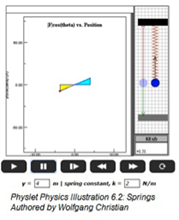 Simple, yet mathematically elegant animation for helping students visualize why the Work-Energy Theorem works in calculating spring force. You can change the initial position and the spring constant. The animation is accompanied by a well-crafted text description of what's going on.
Simple, yet mathematically elegant animation for helping students visualize why the Work-Energy Theorem works in calculating spring force. You can change the initial position and the spring constant. The animation is accompanied by a well-crafted text description of what's going on.
Labs and Investigations
- The Physics Classroom, The Laboratory, It's All Uphill
Students investigate the effect of the angle of incline upon the amount of force and the work done in pulling a cart up a hill to the same height at a constant speed.
- The Physics Classroom, The Laboratory, It's All Uphill - The Sequel
Students pull a cart up an inclined plane at a constant speed to varying heights and investigate the effect of the height upon the amount of work done.
- The Physics Classroom, The Laboratory, Powerhouse
Students determine their power rating by timing their path up a flight of stairs.
- The Physics Classroom, The Laboratory, Marble Energy
A marble rolls down an inclined ruler, hits a note card and rolls to a stop. Students investigate the effect of release location on the distance that the note card is moved before the marble stops rolling.
- The Physics Classroom, The Laboratory, Marble Energy II
Similar to the above lab but students investigate the effect of the incline angle upon the distance that the note card is moved.
Link: http://www.physicsclassroom.com/lab/index.html#energy
Minds On Physics Internet Modules:
The Minds On Physics Internet Modules are a collection of interactive questioning modules that target a student’s conceptual understanding. Each question is accompanied by detailed help that addresses the various components of the question.
- Work and Energy module, Ass’t WE1 - Work
- Work and Energy module, Ass’t WE2 - Power
- Work and Energy module, Ass’t WE3 - Kinetic and Potential Energy
- Work and Energy module, Ass’t WE4 - Total Mechanical Energy
Concept Building Exercises:
- The Curriculum Corner, Work, Energy and Power, Work
- The Curriculum Corner, Work, Energy and Power, Power
- The Curriculum Corner, Work, Energy and Power, Work and Power Calculations
- The Curriculum Corner, Work, Energy and Power, Energy
Link: http://www.physicsclassroom.com/curriculum/energy
Problem-Solving Exercises:
- The Calculator Pad, Energy, and Power, Problems #1 - #14
Science Reasoning Activities:
- The Science Reasoning Center – Energy - Hot Wheels Stopping Distance
Link: http://www.physicsclassroom.com/reasoning/momentum
Real Life Connections:
- Sankey Diagrams
 Sankey diagrams are a specific type of flow chart in which the width of arrows is proportional to the flow quantity. They are often used to visualize energy transfers between processes or systems. This website shares hundreds of Sankey diagrams available for free download and offers links to open source Sankey Diagram builders available for free. You can search by keyword to find diagrams specific to energy flow. For example, we found the following diagram by searching on "Energy flow in turbines".
Sankey diagrams are a specific type of flow chart in which the width of arrows is proportional to the flow quantity. They are often used to visualize energy transfers between processes or systems. This website shares hundreds of Sankey diagrams available for free download and offers links to open source Sankey Diagram builders available for free. You can search by keyword to find diagrams specific to energy flow. For example, we found the following diagram by searching on "Energy flow in turbines".
http://www.sankey-diagrams.com/what-it-takes-to-power-a-bulb/
GREAT way for students to visualize flow of energy in systems and to see that energy is never "lost", but often is converted to less useful forms.
- Walk Through a Hydroelectric Plant
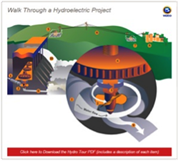 This virtual tour takes you through a hydroelectric power plant. It begins as water from a reservoir flows through a large pipe at the bottom of a dam and acts to power a giant turbine. The images clearly illustrate two types of energy transformation: 1) Gravitational potential energy transforms to mechanical energy when rushing water turns the turbine, and 2) Mechanical energy is transformed to electrical energy by the excitation of electrons within magnets in the turbine shaft.
This virtual tour takes you through a hydroelectric power plant. It begins as water from a reservoir flows through a large pipe at the bottom of a dam and acts to power a giant turbine. The images clearly illustrate two types of energy transformation: 1) Gravitational potential energy transforms to mechanical energy when rushing water turns the turbine, and 2) Mechanical energy is transformed to electrical energy by the excitation of electrons within magnets in the turbine shaft.
Common Misconceptions:
- Work is Always Done When an Object Moves
For positive work to be done on an object, a force must be causing the object to move. An object set in motion will continue in motion at a constant speed; an unbalanced force is not required to keep such an object going. Thus, an object can move not have a force causing its motion at that instant in time.
- Work is Always Done When a Force is Applied
It is not sufficient that a force be applied in order for work to be done. One can push against a wall for a considerable length of time without doing work on the wall. The force that is exerted on the object must be causing a displacement of that object in order for positive work to be done.
- Confusion of Power and Work
Work and power are related by quite different concepts. Power refers to the rate at which work is done. Students often compare the rate at which work is done with the amount of work that is done. Provide numerous opportunities for students to work through the distinction between these two concepts.
- An Object At Rest Does Not Have Energy
Students can often be caught in the belief that an at-rest object does not possess any mechanical energy. Ignoring the concept of potential energy, students will view an object with no kinetic energy as an object with no mechanical energy.
Interactive Homework Problems:
The problems below were crafted by the University of Illinois Physics Education Research Group (PER). They use a scaffolded approach to problem-solving that involves three steps:
- conceptual analysis of the key ideas,
- strategic analysis of methods to consider for solving the problem, and
- help with the calculations.
Probing questions are used to guide students step-by-step through the problem-solving process without spoon feeding. The “help” sequence is user-activated and provides immediate feedback through each step of the exercise. Immediate feedback is received for both correct and incorrect responses.
- PER Interactive Problem: Bobsled Digital Homework Problem
 This problem relates to net displacement of a bobsled completing a double-hill run. It’s designed to promote understanding of how to use the Work-Energy Theorem to solve problems that would be difficult or impossible using the kinematic equations. Given are mass, coefficient of friction, and height of each hill. The student’s task is to figure out the stopping distance once the bobsled reaches the horizontal plateau.
This problem relates to net displacement of a bobsled completing a double-hill run. It’s designed to promote understanding of how to use the Work-Energy Theorem to solve problems that would be difficult or impossible using the kinematic equations. Given are mass, coefficient of friction, and height of each hill. The student’s task is to figure out the stopping distance once the bobsled reaches the horizontal plateau.
- PER Interactive Problem: Pulley and Two Masses Digital Homework Problem
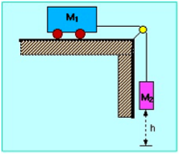 In this problem, a cart and a block are connected by a string passing over an ideal pulley. Students are given the mass of both objects and distance of motion. Their task is to determine the work done on the cart by the string. We like this problem because students choose whether to solve the it using Newton’s Second Law or the Work-Kinetic Energy Theorem.
In this problem, a cart and a block are connected by a string passing over an ideal pulley. Students are given the mass of both objects and distance of motion. Their task is to determine the work done on the cart by the string. We like this problem because students choose whether to solve the it using Newton’s Second Law or the Work-Kinetic Energy Theorem.
Standards:
A. Next Generation Science Standards (NGSS)
Performance Expectations – Physical Science: Energy
- Middle School MS-PS3-1: Construct and interpret graphical displays of data to describe the relationships of kinetic energy to the mass of an object and to the speed of an object.
- High School HS-PS3-1: Use or create a computational model to calculate the change in the energy of one component in a system when the change in energy of the other component(s) and energy flows in and out of the system are known.
- High School HS-PS3-3: Design, build, and refine a device that works within given constraints to convert one form of energy into another form of energy.
Disciplinary Core Ideas – Physical Science: Energy – Definitions of Energy
- Middle School MS.PS3.a.iii: Motion energy is properly called kinetic energy; it is proportional to the mass of the moving object and grows with the square of its speed.
- Middle School MS.PS3.a.iv: A system of objects may also contain stored (potential) energy, depending on their relative positions.
- High School HS-PS3.a.ii: Energy is a quantitative property of a system that depends on the motion and interactions of matter and radiation within that system. That there is a single quantity called energy is due to the fact that a system's total energy is conserved, even as, within the system, energy is continually transferred from one object to another and between its various possible forms.
- High School HS-PS3.a.iii: At the macroscopic scale, energy manifests itself in multiple ways, such as in motion, sound, light, and thermal energy.
Disciplinary Core Ideas – Physical Science: Energy – Conservation of Energy/EnergyTransfer
- Middle School MS-PS3.b.i: When the motion energy of an object changes, there is inevitably some other change in energy at the same time.
- Middle School MS-PS3.c.i: When two objects interact, each one exerts a force on the other that can cause energy to be transferred to or from the object.
- High School HS-PS3.b.ii: Energy cannot be created or destroyed, but it can be transported from one place to another and transferred between systems.
- High School HS-PS3.B.iii: Mathematical expressions, which quantify how the stored energy in a system depends on its configuration (e.g. relative positions of charged particles, compression of a spring) and how kinetic energy depends on mass and speed, allow the concept of conservation of energy to be used to predict and describe system behavior.
Crosscutting Concepts
Patterns
- Middle School: Patterns can be used to identify cause and effect relationships.
- Middle School: Graphs, charts, and images can be used to identify patterns in data.
- Middle School: Patterns in rates of change and other numerical relationships can provide information about natural systems.
Cause and Effect
- Middle School: Cause and effect relationships may be used to predict phenomena in natural systems.
- High School: Systems can be designed to cause a desired effect.
- High School: Cause and effect relationships can be suggested and predicted for complex natural systems by examining what is known about smaller-scale mechanisms within the system.
Systems and System Models
- Middle School: Models can be used to represent systems and their interactions, such as inputs, processes and outputs, and energy, matter, and information flows within systems.
- High School: Models (e.g. physical, mathematical, computer models) can be used to simulate systems and interactions – including energy, matter, and information flows – within and between systems at different scales.
Energy and Matter
- Middle School: The transfer of energy can be tracked as energy flows through a designed or natural system.
- Middle School: Within a natural or designed system, the transfer of energy drives the motion and/or cycling of matter.
- High School: Changes of energy and matter in a system can be described in terms of energy and matter flows into, out of, and within that system.
- High School: Energy cannot be created or destroyed – it only moves between one place and another, between objects and/or fields, or between systems.
Science and Engineering Practices
Practice #2: Developing and Using Models
- Middle School: Develop a model to describe unobservable mechanisms.
- High School: Use a model based on evidence to illustrate the relationships between systems or between components of a system.
- High School: Use a model to provide mechanistic accounts of phenomena.
Practice #4: Analyzing and Interpreting Data
- High School: Analyze data using tools, technologies, and/or models (e.g. computational, mathematical) to make valid and reliable scientific claims or determine an optimal design solution.
Practice #5: Constructing Explanations
- High School: Construct and revise an explanation based on valid and reliable evidence obtained from a variety of sources (including students' own investigations, models, theories, simulations, peer review) and the assumption that theories and laws that describe the natural world operate today as they did in the past and will continue to do so in the future.
Practice #8: Using Mathematics and Computational Thinking
- High School: Use mathematical representations of phenomena to describe explanations.
- High School: Use a computational representation of phenomena to describe and/or support claims and/or explanations.
B. Common Core Standards for Mathematics (CC) – Grades 9-12
Standards for Mathematical Practice:
- MP.1 - Make sense of problems and persevere in solving them.
- MP.4 - Model with mathematics
- MP.2 - Reason abstractly and quantitatively
High School Algebra: Creating Equations
- A-CED.4 – Rearrange formulas to highlight a quantity of interest, using the same reasoning as solving equations.
High School Functions: Interpreting Functions
- F-IF.4 - For a function that models a relationship between two quantities, interpret key features of graphs and tables in terms of the quantities, and sketch graphs showing key features given a verbal description of the relationship.
- F-IF.6 - Calculate and interpret the average rate of change of a function over a specified interval. Estimate the rate of change from a graph.
High School Functions: Linear, Quadratic, and Exponential Models
- F-LE.1.b: Recognize situations in which one quantity changes at a constant rate per unit interval relative to another.
- F-LE.1.c: Recognize situations in which a quantity grows or decays by a constant percent rate per unit interval relative to another.